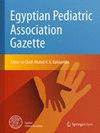The impact of red blood cell transfusion in preterm neonates on germinal matrix hemorrhage: incidence and grade with correlation to outcome
IF 0.5
Q4 PEDIATRICS
引用次数: 0
Abstract
Abstract Background Germinal matrix hemorrhage affects 20 to 25% of infants with a low birth weight (less than 1500 g). About one-tenth of them progress to intra-parenchymal hemorrhage, usually during the first days after birth. Several studies have found a correlation between packed RBC transfusions and a higher frequency of severe germinal matrix hemorrhage in neonatal intensive care units. Transcranial ultrasound is a safe, noninvasive modality that can be used repeatedly in the neonates with ability to detect different grades of germinal matrix hemorrhage. Objective Was to evaluate the impact of packed RBC transfusion on the incidence and grade of germinal matrix hemorrhage, as evaluated by transcranial Doppler, and correlation to outcome. Methods This prospective observational study included one hundred preterm infants admitted to NICU, suffering from GM hemorrhage throughout 9 months duration. Bedside transcranial ultrasound was done for all the patients with a correlation of the grade of hemorrhage to the onset of blood transfusion, different clinical parameters, and the outcome. Results Statistical analysis showed a significant relation between the age of the first PRBC transfusion and GM hemorrhage grade. A positive relation was found between total amounts of PRBC transfusion and increasing grade of GM hemorrhage. A negative relation was found between GM hge grades and Apgar scores. GM hge patients who received PRBC transfusion had lower mean birth weight, lower gestational age, and longer duration of hospital stay than those who have not received PRBC transfusion. Conclusion Close monitoring of preterm neonates receiving packed RBCs, by transcranial ultrasound, as early as possible, is mandatory to early detect GM hge and limit subsequent morbidities.早产儿输注红细胞对生发基质出血的影响:发生率和分级与预后的关系
背景生发基质出血影响20%至25%的低出生体重婴儿(小于1500 g),其中约十分之一进展为实质内出血,通常发生在出生后的头几天。几项研究发现,在新生儿重症监护病房中,充血性红细胞输注与较高频率的严重生发基质出血之间存在相关性。经颅超声是一种安全、无创的方法,可以反复用于有能力检测不同程度的生发基质出血的新生儿。目的探讨经颅多普勒评价充血性红细胞输注对生发基质出血发生率、分级的影响及其与预后的关系。方法:本前瞻性观察研究纳入100例新生儿重症监护病房(NICU)的GM出血早产儿,随访时间为9个月。所有患者床边经颅超声检查出血程度与输血开始、不同临床参数及结果的相关性。结果统计分析显示,首次输血年龄与GM出血分级有显著相关性。PRBC总输注量与GM出血加重程度呈正相关。GM评分与Apgar评分呈负相关。接受PRBC输血的GM患者比未接受PRBC输血的患者平均出生体重更低,胎龄更低,住院时间更长。结论尽早通过经颅超声密切监测接受填充红细胞的早产儿,对早期发现GM大鼠和限制后续发病具有重要意义。
本文章由计算机程序翻译,如有差异,请以英文原文为准。
求助全文
约1分钟内获得全文
求助全文
来源期刊

Egyptian Pediatric Association Gazette
PEDIATRICS-
自引率
0.00%
发文量
32
审稿时长
9 weeks
期刊介绍:
The Gazette is the official journal of the Egyptian Pediatric Association. The main purpose of the Gazette is to provide a place for the publication of high-quality papers documenting recent advances and new developments in both pediatrics and pediatric surgery in clinical and experimental settings. An equally important purpose of the Gazette is to publish local and regional issues related to children and child care. The Gazette welcomes original papers, review articles, case reports and short communications as well as short technical reports. Papers submitted to the Gazette are peer-reviewed by a large review board. The Gazette also offers CME quizzes, credits for which can be claimed from either the EPA website or the EPA headquarters. Fields of interest: all aspects of pediatrics, pediatric surgery, child health and child care. The Gazette complies with the Uniform Requirements for Manuscripts submitted to biomedical journals as recommended by the International Committee of Medical Journal Editors (ICMJE).
 求助内容:
求助内容: 应助结果提醒方式:
应助结果提醒方式:


